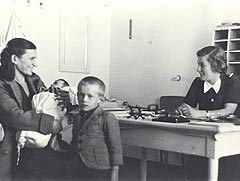Child Health
Sixty years of the NHS have seen huge strides in healthcare, many of which have helped transform the health and wellbeing of children and young people.
In the 1940s diphtheria, rheumatic fever, measles and whooping cough were common, cancer was usually incurable, a child born with cystic fibrosis would rarely survive the early years of life and one in twenty children died in infancy. Well-structured public health and immunisation programmes, antibiotic treatment for bacterial infections, improved social and environmental circumstances and the wider benefits of advancing medical knowledge have individually and collectively transformed the pattern and frequency of childhood illnesses.
The infant death rate has improved tenfold; previously common childhood illnesses are rare; over 75 per cent of children with cancer survive and the life expectancy of patients with cystic fibrosis is increasing significantly with every passing decade.
Recent decades have also brought increasing opportunities for the early detection of disease. Screening programmes during pregnancy and in the newborn period now allow the early identification of a range of serious conditions and complex congenital abnormalities. This sometimes allows choices regarding the continuation of a pregnancy and in other cases supports effective early interventions, even in the first few days of life.
But success has not been without its own problems. One example is the improved care of premature babies. The likelihood that a very low birth weight baby will survive has increased fourfold over the past 40 years but around one third of survivors will be disabled, half of them severely. The needs of such patients pose new, long-term and often complex challenges for their families and the NHS and represent one of many areas where NHS staff are increasingly being required to work in close collaboration with other agencies such as social care, education and the voluntary sector.
This requirement for the NHS to be part of a much wider approach to health and health care is also seen in the pattern of health problems now facing children and young people. Obesity, substance misuse, teenage pregnancies and the sad reality that 10 per cent of children have disorders of mental health affecting their daily life are all issues that require concerted efforts across society if current trends are to be reversed.
But perhaps one of the most dramatic changes in the past 60 years has been in the simple fact that we have come to understand that children are not simply small adults. In the 1940s and 50s many children in hospital were in adult wards, being treated by adult clinicians and subject to severely restricted visiting regimes such that sometimes parents were only able to visit once a week.
That has all changed radically, and for the better. The majority of children in hospital will now be cared for in dedicated facilities and by staff trained in the specific and different needs of a child. Importantly, the role of parents is increasingly recognised and it is now common not only for parents to stay in the hospital but for them also to be present, for example, when their child is given anaesthetic or wakes up in the recovery area – a much more child friendly NHS than in 1948!
Morgan Jamieson
National Clinical Lead for Children and Young People's Health

One debate that has gone on since the early years of the NHS is about how we care for young people, especially when they are in hospital. In 1993 a Scottish Office report recognised that ‘adolescents have distinctive and different needs from both child and adult patients’ and the specific emotional, psychosocial and developmental needs of the teenage years are increasingly acknowledged. These issues are all the more important when a young person is coping with serious or long-term illness alongside all the changes that accompany adolescence, including a growing independence from parental care.
In practice young people have traditionally been admitted to children’s units, focussed primarily on much younger children and infants, or adult wards with a predominantly elderly population.
Things are changing. Dedicated services and facilities are beginning to appear. But a challenge remains to ensure that the NHS of the future treats young people as …young people.
